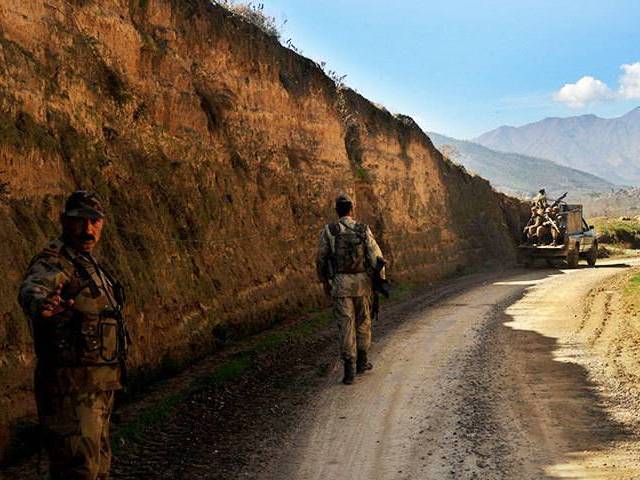
Since the Peshawar school attack, the national consensus to root out any terrorist safe haven in the country has been unflinching. However, not everyone is mindful of how huge is the mission within the country’s limited means. Neither media-persons nor the civil society protested against the secretive nature of the operation until the last trip to Waziristan. The chopper flew over valleys and mountain slopes dotted with villages and hamlets. A vast majority of empty residential structures were devoid of rooftops.
How to spot a militant: Pakistan army removes roofs in Waziristan
The military officials justified it, stating it was the most viable manner to keep a vigil on the areas cleared of militants. According to them, the landscape is treacherous with sufficient camouflage to an insurgent or guerilla fighter to sneak back in, with limited risk of being spotted. The other option, however, could have been to deploy troops on each village in sufficient numbers to keep a vigil.
The cost of reconstructing rooftops was thought to be less expensive than deploying armed manpower for security of each cleared hamlet and valley. Even if Pakistan was equipped and could afford, technology has serious limitations in counter-insurgency operations. Moreover, the terrain in the Waziristan region could not have been more challenging.
Spiral of issues
The issue is not only limited to missing rooftops. The remaining structures do not look strong enough to hold a roof whenever built. Having withstood tremors of arms explosions and harsh weather, the walls are now crumbling. The region also has to start afresh from livelihood and livestock. The militias have already taken a toll on trees and crops while, the military operation is further stressing the echo system.
The counter-insurgency campaigns by the British in Malaysia, French in Algeria and US in Vietnam are proof of awful tactics, resulting in massive loss of human lives and environmental destruction.
For Waziristan, however, the population largely left their homes to take refugee in camps or with relatives across the country. The issue of loss of civilian lives never emerged. Was the force used excessively against the militants? Only when more Internally Displaced People (IDPs) return home and media gets extensive free access, the nation can have a better idea.
Army clears last militant stronghold in North Waziristan
But can the government of Pakistan foot the bill of reconstruction of the region beyond setting up military camps? The answer appears a hesitant and ungenerous yes. The federal government has so far left it all to the military to secure the area from militants. Prime Minister Nawaz Sharif has not shown keen political interest in the Federally Administered Tribal Areas (Fata) region in general, and Waziristan in particular.
Does this mean military will be relied upon again to supervise reconstruction process? If so, it will be retreating more civilian space to military while knowing the armed forces are not cut-out for such long term tedious affairs. The tribesmen, on the other hand, have high expectations from the state. They will not be satisfied with high praise in the absence of enabling atmosphere for them to resume their lives and livelihood with dignity.
Guiding through previous debacles
After the military operation formally ends, the remaining part of war will be won with right priorities, financial as well as political. As quoted in the AFP report, the military estimates the cost of reconstruction at $285 million, of which Islamabad has only released $48 million. Each registered household will be paid Rs400,000 to rebuild a home or a business. If experiences of 2005 earthquake and 2010 floods can guide, the question of when the compensation will be paid becomes equally crucial to the amount to be given per head.
The IDPs will need the money in trouble-free manner as they return to their villages or towns. The delay will not only slow down their lives further but also create frustration and anger, which can be exploited by certain vested interests. The lacklustre budget proposals, announced on Friday, offer little hope for marginalised regions such as Fata.
Equally significant are political reforms across the entire federally and provincially administered tribal regions. The parliamentary activity concerning the issues has been lacklustre. As a result, the local elders lack confidence in the parliament where they believe certain interest groups obstruct the case for constitutional reforms for Fata. Shamefully, amendments to the Frontiers Crimes Regulation are yet to be initiated which could have been the first confidence building measure.
Pakistan has already lost two opportunities of reconstructing important regions along modern lines with better town planning. The Azad Jammu and Kashmir and parts of Khyber-Pakhtunkhwa could have been transformed through a well-planned reconstruction process after 2005 earthquake. The blunder was repeated again in southern Punjab in 2010 and Sindh in 2011. But unlike the past, the stakes are much higher in the tribal regions, as Pakistan has paid dearly to reclaim peace and calm in Waziristan.
Naveed Ahmad is a Pakistani investigative journalist and academic with extensive reporting experience in the Middle East and North Africa. He is based in Doha and Istanbul. He tweets @naveed360










































COMMENTS (2)
Comments are moderated and generally will be posted if they are on-topic and not abusive.
For more information, please see our Comments FAQ